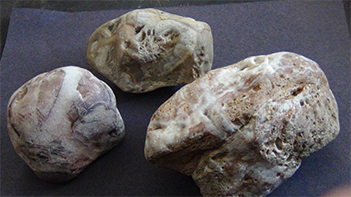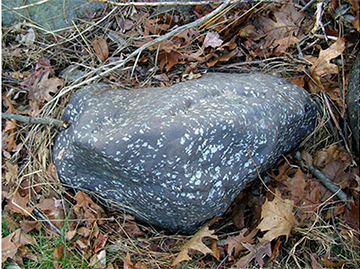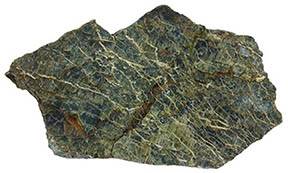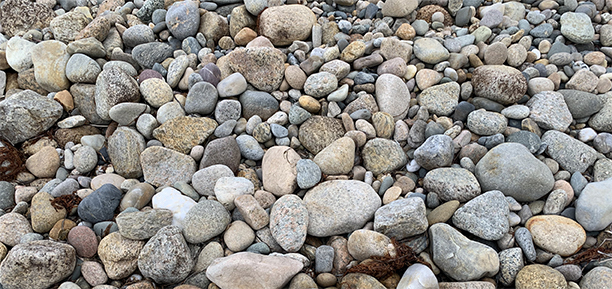By Bill Wilcox
What tales they would tell!
Oh, but they can speak, if you can read their language. It’s a language of enormous time and the depths from which they came. It is their bands of color and minerals that tell the tale. It speaks of convulsions in the earth’s interior involving intrusions of molten magma, enormous cracks in the buried rock that filled with crystals precipitated from hot fluids that separated out from magma about to be erupted at the surface of an ancient earth.
As you probably know, the Vineyard is a thick pile of glacial debris left behind by the Wisconsin ice sheet that left our area about 20,000 years ago. While the glacial deposits are relatively young in terms of earth history, they include untold numbers of very old rocks.
Let me explain. Glaciers form during climatic cold periods where more snow falls in the winter than melts the following summer. Year after year, the snow piles up and compresses into ice and; when it thickens enough, the ice moves by a process of plastic deformation. As surprising as it may be, there are mountain glaciers that move forward by 100 feet or more per day!
Over some thousands of years ice from Canada flowed to the Vineyard. While the continental ice caps that grew during the glacial epoch didn’t move that fast, they did creep along. The huge thickness and weight that they brought ground and gouged the bedrock as they moved. Freeze and thaw below the ice plucked large rocks out of the bedrock as well as sand and gravel, and gradually moved it up into the heart of the ice sheet.
As you walk the beach at Cedar Tree Neck Sanctuary, it is striking to think that all the sediment you see was carried here in glacial ice from somewhere to the north. Some of the rocks you might see are so distinct and unusual that they tell us exactly where the ice came from.
Diamond Hill Agate
 The Diamond Hill agate at Cedar Tree Neck is from one small patch of a 500-foot hill in Cumberland, Rhode Island. An agate is made of quartz, a common and very stable mineral that comprises a large fraction of beach sand. The Diamond Hill agate includes very small crystals of quartz (also called chalcedony) that may be colored by iron to a range of colors from creamy white, to coffee colored tan and on to dull red and greenish. The colors are usually banded, so that the rocks may show layers of color, which are sometimes broken up into shorter pieces and cemented into a jumble. In addition, there are usually small cavities (vugs) that contain small (but sometimes visible with the naked eye) quartz crystals that are well formed and clearly visible with magnification. In general, agates form in areas of volcanic activity where waters, rich in dissolved silica (the primary component of quartz), flow through fractures and cavities in the surrounding rocks. When the solution is highly concentrated with dissolved silica, a silica gel can form on the walls of these cavities. That gel will slowly crystallize to form microcrystalline quartz. Cumberland, Rhode Island was the site of volcanic activity when the Diamond Hill agate formed in large cracks in the surrounding bedrock at great depth. The exact age of the agate is not clear but the rocks it is surrounded by are 300 million years old. The exposed rock is found over a mile long area and ascends in places to a 300 foot cliff.
The Diamond Hill agate at Cedar Tree Neck is from one small patch of a 500-foot hill in Cumberland, Rhode Island. An agate is made of quartz, a common and very stable mineral that comprises a large fraction of beach sand. The Diamond Hill agate includes very small crystals of quartz (also called chalcedony) that may be colored by iron to a range of colors from creamy white, to coffee colored tan and on to dull red and greenish. The colors are usually banded, so that the rocks may show layers of color, which are sometimes broken up into shorter pieces and cemented into a jumble. In addition, there are usually small cavities (vugs) that contain small (but sometimes visible with the naked eye) quartz crystals that are well formed and clearly visible with magnification. In general, agates form in areas of volcanic activity where waters, rich in dissolved silica (the primary component of quartz), flow through fractures and cavities in the surrounding rocks. When the solution is highly concentrated with dissolved silica, a silica gel can form on the walls of these cavities. That gel will slowly crystallize to form microcrystalline quartz. Cumberland, Rhode Island was the site of volcanic activity when the Diamond Hill agate formed in large cracks in the surrounding bedrock at great depth. The exact age of the agate is not clear but the rocks it is surrounded by are 300 million years old. The exposed rock is found over a mile long area and ascends in places to a 300 foot cliff.
Cumberlandite
 Another unique rock is cumberlandite, which also arrived here from Cumberland, RI. While not yet found at Cedar Tree Neck, the glacial flow path that carried the agates here should have brought some. Cumberlandite contains a large fraction of iron and titanium in the form of the magnetic mineral, magnetite. (A small horseshoe magnet will cling to these rocks.) They formed in a magma chamber deep in the earth when the heavier crystals sank and accumulated toward the bottom of the chamber. Cumberlandite was rich enough in iron to be mined before the Revolutionary War. It often contains larger, creamy-white crystals of one of the feldspar minerals, that may weather out, leaving pits in the rock.
Another unique rock is cumberlandite, which also arrived here from Cumberland, RI. While not yet found at Cedar Tree Neck, the glacial flow path that carried the agates here should have brought some. Cumberlandite contains a large fraction of iron and titanium in the form of the magnetic mineral, magnetite. (A small horseshoe magnet will cling to these rocks.) They formed in a magma chamber deep in the earth when the heavier crystals sank and accumulated toward the bottom of the chamber. Cumberlandite was rich enough in iron to be mined before the Revolutionary War. It often contains larger, creamy-white crystals of one of the feldspar minerals, that may weather out, leaving pits in the rock.
Serpentinite
 Serpentinite is another rock that is scarce on the Vineyard, but is occasionally found along the North shore. This rock is sourced from earth’s oceanic crust and upper mantle. At the subduction zone, where the ocean crust creeps down into the mantle, ocean water carried down becomes an active driver of metamorphism that alters the upper mantle rocks to a new form with different minerals built from the components of its predecessors.
Serpentinite is another rock that is scarce on the Vineyard, but is occasionally found along the North shore. This rock is sourced from earth’s oceanic crust and upper mantle. At the subduction zone, where the ocean crust creeps down into the mantle, ocean water carried down becomes an active driver of metamorphism that alters the upper mantle rocks to a new form with different minerals built from the components of its predecessors.
Other Rocks
Other rocks that can be found on the beach at Cedar Tree Neck include the igneous type rocks called granites and their related rocks. Occasionally a conglomerate is found with numerous rounded pebbles of rock surrounded by a matrix of sand or clay size particles compressed together into a solid rock. Conglomerate is a sedimentary rock and may contain rounded or angular pebbles. Gneiss is a metamorphic rock that is fairly common (pronounced nice). This rock has the general look of granite but it is banded with light and dark layers of minerals. Pictures to guide your identification can readily be found on the Internet. Whether you can identify them or not, the huge number of cobbles found on the beach are colorful with interesting patterns and colors and all qualify as “washashores”.
Bill Wilcox grew up in Edgartown and received his BS and PhM degrees in geology at UMass and Columbia. He worked for the MV Commission for about 35 years as the Water Resource Planner.


